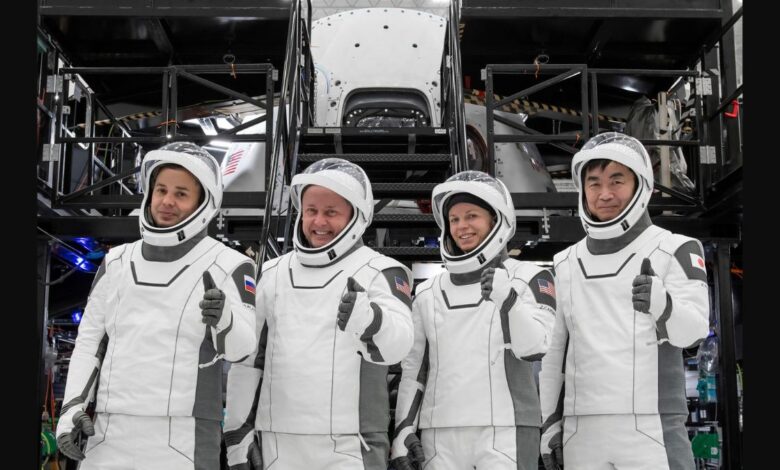NASA Crew-11: Astronauts in Pre-Launch Quarantine

NASA’s Crew-11 Astronauts Enter Pre-Launch Quarantine
NASA’s Crew-11 astronauts have begun their pre-launch quarantine in preparation for their mission to the International Space Station (ISS). This crucial step ensures the health and safety of the crew and the existing ISS team. Let’s delve into the details of this quarantine, the mission’s objectives, and the scientific research planned.
The Crew-11 team, led by NASA astronaut Zena Cardman (commander), includes NASA pilot Nick Hague, ESA astronaut Thomas Pesquet, and Roscosmos cosmonaut Alexander Grebenkin. They commenced their two-week health stabilization protocol at the Johnson Space Center in Houston on July 17, 2025, ahead of a launch targeted for no earlier than July 31, 2025.
Understanding the Pre-Flight Quarantine
The pre-flight quarantine, also known as health stabilization, is a long-standing practice dating back to the Apollo era. Its primary purpose is to minimize the risk of the astronauts contracting any illnesses before their spaceflight. This isolation period significantly reduces the chances of introducing infections to the ISS, safeguarding both the Crew-11 team and the current inhabitants of the space station.
During the 14-day quarantine, the astronauts limit their contact with the outside world and undergo rigorous medical screenings. This proactive approach helps to identify and address any potential health concerns before they can jeopardize the mission. The quarantine is one of the final milestones before the team’s journey to the Kennedy Space Center for launch preparations.
Rigorous Training Regimen
In the months leading up to the quarantine, the Crew-11 astronauts engaged in extensive training across various locations, including Houston, Florida, and California. Their training encompassed a wide range of activities, from mastering the Crew Dragon simulator at SpaceX headquarters in Hawthorne, CA, to practicing emergency escape procedures at Launch Complex 39A at the Kennedy Space Center. This comprehensive training ensures that the crew is well-prepared for any challenges they may encounter during their mission.
Mission Objectives and Scientific Endeavors
Crew-11’s primary objective is to conduct a six-month science expedition aboard the ISS. As part of NASA’s Commercial Crew Program, SpaceX’s Crew Dragon spacecraft provides a reliable and cost-effective means of transporting astronauts to the station for long-duration missions, maintaining a continuous human presence in space.
Scientific Research Highlights
The Crew-11 mission is packed with a diverse array of scientific experiments, including:
- JAXA’s Plant Cell Division Study: Investigating the effects of microgravity on the division of algae and tobacco cells.
- Genes in Space: Exploring the use of bacteriophages as alternatives to antibiotics in space.
- StemCellEx: Studying the growth of stem cells in the unique environment of microgravity.
- BioNutrients: Developing the capability to produce essential vitamins on demand in orbit.
These investigations, along with numerous other studies conducted on the ISS, are crucial for advancing human health and developing life support systems for future deep-space exploration missions. The knowledge gained from these experiments will pave the way for longer and more ambitious voyages beyond Earth.
The Significance of Commercial Crew Program
NASA’s Commercial Crew Program has revolutionized access to space, fostering innovation and competition in the private sector. By partnering with companies like SpaceX, NASA has not only reduced the cost of space travel but also ensured a continuous and reliable means of transporting astronauts and cargo to the ISS.
The Crew-11 mission exemplifies the success of this program, demonstrating the capabilities of the Crew Dragon spacecraft and the benefits of public-private partnerships in space exploration.
Crew-11 Mission: A Summary
| Aspect | Details |
|---|---|
| Crew Composition | Zena Cardman (NASA), Nick Hague (NASA), Thomas Pesquet (ESA), Alexander Grebenkin (Roscosmos) |
| Mission Duration | Six Months |
| Launch Target | No earlier than July 31, 2025 |
| Primary Objective | Scientific Research on the ISS |
| Spacecraft | SpaceX Crew Dragon |
The Crew-11 mission represents a significant step forward in our understanding of space and its potential benefits for humanity. As the astronauts embark on their journey, their research and discoveries will undoubtedly contribute to a brighter future for space exploration and life on Earth.




